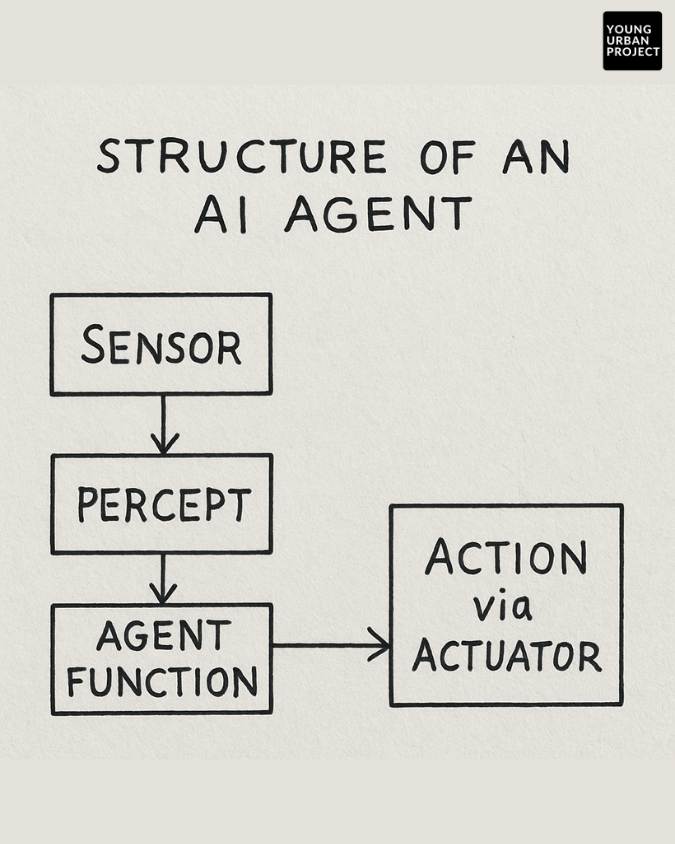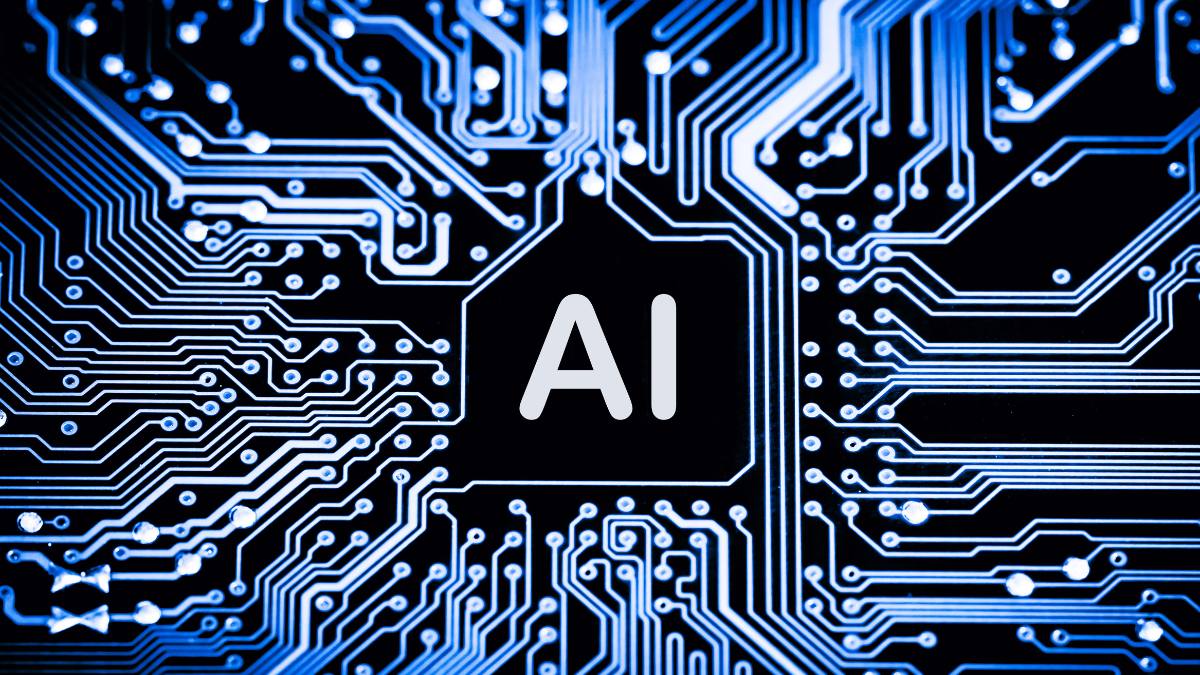The structure of an agent in AI explains how intelligent systems observe their surroundings, make decisions, and take action. At its core, it includes sensors to gather data, actuators to interact with the environment, and a function that decides what to do based on what it senses. Different types of agents, like reflex-based, goal-driven, or learning agents, handle tasks in unique ways. Their design depends heavily on the environment they operate in. Understanding this structure helps developers build smarter, more efficient AI systems suited for real-world use, from self-driving cars to recommendation engines and smart home devices.
Table of Contents
What is an Agent in AI?
An agent in artificial intelligence is any entity that can perceive its environment through sensors and act upon it using actuators. Think of it as a loop: it sees or senses something, decides what to do, and then acts.
Here’s a simple analogy: a self-driving car is a classic example of an AI agent. Its cameras and radar act as sensors. Its steering, acceleration, and braking systems act as actuators. It’s constantly analyzing what’s around it, other cars, pedestrians, and road signs, and choosing the next best move. That loop of sensing, deciding, and acting is what makes it an agent.
The key idea is: an AI agent is autonomous. It can make decisions on its own, based on the data it perceives.
What is the Structure of an Agent in AI?
The structure of an agent in AI is the foundation of how it works. It’s not just about what the agent does, but how it processes the world around it to take action. At its core, every agent has a few essential components:
1. Sensors
These are the agent’s eyes and ears, what it uses to perceive the environment. Depending on the system, sensors could be:
- Cameras in a robot
- Microphones in a voice assistant
- Temperature detectors in a smart thermostat
- Web data inputs into a recommendation engine
Sensors gather raw data about the state of the world.
2. Actuators
These are the parts that let the agent act. In physical systems, they could be motors, servos, or mechanical parts. In software systems, actions might include sending alerts, modifying data, or triggering other digital processes.
If a thermostat senses that a room is too cold, the actuator is what actually turns on the heater.
3. Percept Sequence
This is essentially the history of everything the agent has perceived so far. Rather than working on just the latest data point, some agents need to analyze trends over time, recognize patterns, or understand cause-effect relationships that emerge across multiple events.
Not every agent uses its full percept sequence, but more complex ones definitely do.
4. Agent Function
This is the real decision-maker. The agent function takes the percept (or percept sequence) and maps it to a specific action. It’s the logic or strategy that says, “Given what I’m sensing, what should I do?”
You could think of the agent function as the brain of the operation, though it can range from something super simple (like a rule-based system) to something highly complex and adaptive (like a deep learning model).

Agent Program vs Agent Function
These two often get mixed up, but they’re not the same.
- Agent Function is the idealized mathematical model. It’s like the full rulebook of what the agent should do in every possible situation, even if that’s not feasible in practice.
- Agent Program is the actual implementation. It’s the code that gets written to carry out the logic of the agent function in a real system, with real constraints.
Think of it like this: a recipe is the function; the robot chef that follows it is the program. And sometimes, the robot needs to tweak things if an ingredient is missing or the oven’s acting up.
Example: Smart Thermostat
Let’s put it all together.
- Sensors: temperature sensor detects 18°C
- Percept Sequence: logs that it’s been under 20°C for 2 hours
- Agent Function: determines the optimal comfort range is 21-23°C
- Actuator: sends a signal to the heater to turn on
Here, the thermostat is making a decision based on environmental input, a memory of recent readings, and a built-in rule set. It doesn’t need a fancy neural network to be an intelligent agent; it just needs the structure to perceive, decide, and act.
Also read: What is Agentic AI?
What Are the Main Types of AI Agents?
This is where it gets interesting. Not all AI agents are built the same. Depending on the complexity of the environment and the task at hand, different types of agents are used.
Let’s explore the five primary types of AI agents and what makes them unique.
1. What is a Simple Reflex Agent?
These agents operate on IF-THEN rules. They don’t remember past actions or look ahead. They just act based on the current situation.
- Behavior: “If I see dirt, start vacuuming.”
- No memory or planning
- Only responds to current percept
Example: A basic vacuum cleaner robot. It detects dirt → it moves. That’s it. If it hits a wall, it turns.
Simple? Yes. Effective in limited scenarios? Absolutely.
2. What is a Model-Based Reflex Agent?
These agents are a step up. They maintain some kind of internal state that represents part of the world they can’t directly sense at the moment.
This means they can handle situations where not everything is visible all the time.
- Keeps a model of the world
- Updates internal state as new data comes in
Example: A home security system. If a window sensor is triggered and no one disarmed the alarm, it assumes a break-in. It remembers past states (armed, disarmed, motion detected) and acts accordingly.
3. What is a Goal-Based Agent?
Here’s where decision-making gets more sophisticated. A goal-based agent doesn’t just react; it evaluates whether an action will help it achieve a goal.
- Plans ahead
- Considers different outcomes
- Chooses based on what gets it closer to its goal
Example: A chess-playing AI. It doesn’t just move a piece because it can, it simulates potential future moves and picks the one most likely to lead to a win.
These agents require more computing power but offer far more intelligent behavior.
Also Read: 10 Essential Skills to Build AI Agents
4. What is a Utility-Based Agent?
While goal-based agents focus on reaching a specific outcome, utility-based agents go a level deeper. They’re not just trying to “win the game”, they want to win in the best possible way.
A utility-based agent doesn’t just ask “Does this action achieve my goal?” It asks, “How good is this outcome compared to all other possible outcomes?”
- Evaluates multiple outcomes
- Uses a utility function to rank them
- Chooses the action with the highest utility
Example: A self-driving car.
Let’s say the goal is to reach a destination. That could be done by taking the shortest route, but what if that road is congested or has a high accident rate? A utility-based agent factors in safety, speed, fuel efficiency, and maybe even passenger comfort, and picks the best route accordingly.
It’s about maximizing value, not just hitting a target.
5. What is a Learning Agent?
This is where the magic really happens.
A learning agent is capable of improving its behavior over time by learning from experience. Instead of being pre-programmed with fixed rules, it adjusts its strategies based on feedback.
These agents typically have four components:
- Learning Element – This is what makes improvements based on performance.
- Performance Element – Responsible for selecting actions.
- Critic – Gives feedback about how the agent is doing relative to a standard.
- Problem Generator – Suggests exploratory actions to improve learning.
Example: Think of how recommendation engines like Netflix or YouTube work. They learn from what you watch, how long you watch, when you skip, and start adjusting what they show you next. That’s learning in action.
These systems are especially useful in environments where things change over time or where the full set of rules isn’t known upfront.

Enroll Now: AI Marketing Course
How Does the Environment Affect Agent Structure?
The type of environment in which an AI agent operates directly influences how it should be designed.
Why? Because an agent that performs great in one environment could fall apart in another.
Here’s a breakdown of environmental types, and why they matter:
1. Fully vs. Partially Observable
- Fully Observable: The agent has access to all the info it needs to make decisions. Example: A board game like chess.
- Partially Observable: Some elements are hidden. Example: Real-world driving, can’t always see around corners or through fog.
Impact: Partially observable environments often require model-based or learning agents that can reason with incomplete data.
2. Deterministic vs. Stochastic
- Deterministic: The outcome of actions is predictable. Example: Calculating a math formula.
- Stochastic: Outcomes include randomness. Example: A delivery drone flying in windy conditions.
Impact: Stochastic environments need agents that can handle uncertainty and still make optimal decisions (like utility-based agents).
3. Episodic vs. Sequential
- Episodic: Each decision is independent of past ones. Example: Image classification, label each image individually.
- Sequential: Current actions affect future decisions. Example: Navigating a maze or a chatbot conversation.
Impact: Sequential environments require agents that track state and make long-term plans.
Also read: Generative AI vs Predictive AI: Key Differences
4. Static vs. Dynamic
- Static: The world doesn’t change while the agent is deciding. Example: Solving a puzzle.
- Dynamic: The world keeps moving. Example: Trading stocks, or playing a real-time video game.
Impact: Dynamic environments demand faster, more responsive agents that can adapt on the fly.
5. Discrete vs. Continuous
- Discrete: Finite number of states or actions. Example: Tic-tac-toe.
- Continuous: Infinite possibilities. Example: Steering a car, adjusting speed.
Impact: Continuous environments require agents with fine-grained control and often some kind of optimization strategy.
Also read: Knowledge-Based Agents in AI: The Ultimate Guide
Agent Function vs Agent Program: What’s the Difference?
This question pops up all the time, and it’s a good one.
On paper, the agent function is the ideal. It’s the perfect mapping between every possible situation and the right action to take. But in practice? That’s often impossible to define exhaustively.
The agent program is what we actually build, the software that runs inside the agent and makes real-time decisions.
Think of it like:
- Agent Function = The strategy
- Agent Program = The execution
Analogy: Recipe vs. Robot
Imagine a gourmet recipe that outlines exactly how to make a complex dish, down to every gram and second. That’s your agent function.
Now imagine a kitchen robot that reads the recipe and actually cooks it. It might make tiny adjustments based on available ingredients, the current temperature, or whether it dropped a spoon. That’s your agent program.
Also read: Main Goal of Generative AI
Why Understanding Agent Structure Matters in AI Development
If you’re building or working with AI systems, knowing the structure of an agent isn’t just theory, it’s a shortcut to making smarter design decisions.
Here’s why it matters:
1. Better Decision-Making
When you understand how sensors, actuators, and decision logic fit together, you can fine-tune each part for performance.
For example, a delivery drone’s performance might be improved more by upgrading its navigation model (agent function) than by adding extra sensors.
2. Scalable AI Models
A well-structured agent is easier to scale.
If you’ve built a clean architecture, you can upgrade parts without overhauling the entire system, like swapping in a better learning element without touching the actuator controls.
3. Optimized Resource Usage
Not every problem needs a complex learning agent. Sometimes a simple reflex agent does the job perfectly and consumes far less processing power.
Knowing the structure lets you match complexity to the problem, avoiding wasted resources.
4. Higher ROI in Automation Projects
When businesses choose the right agent type for the environment they’re operating in, they see better results faster. That’s more value for every dollar spent on development and deployment.
Also read: Rational Agents in AI: Working, Types and Examples
Summary Box
- Definition: An AI agent perceives, decides, and acts based on defined structures.
- Core Components: Sensors, actuators, agent function, performance measure.
- 5 Types: Simple reflex, model-based, goal-based, utility-based, learning agents.
- Examples: Tesla Autopilot (utility-based), Roomba (simple reflex), Google Maps (goal + utility hybrid), Netflix recommendations (learning).
- Why It Matters: Understanding structure leads to smarter AI design, better resource use, and higher performance in automation.
Also Read: Top 10 AI Agent Frameworks to Build Smarter AI
FAQs: Structure of Agent in AI
Q1: What is the structure of an agent in AI?
The structure includes sensors, actuators, percept history, and an agent function that decides what action to take based on environmental input.
Q2: What are the main components of an AI agent?
Sensors (input), actuators (output), agent function (decision logic), and performance measure (evaluates success).
Q3: What are the 5 types of AI agents?
Simple reflex, model-based reflex, goal-based, utility-based, and learning agents.
Q4: What is the difference between an agent program and an agent function?
The agent function is the theoretical mapping from perception to action. The agent program is the practical implementation of that mapping.
Q5: How do environments affect agent structure?
The nature of the environment, whether it’s static or dynamic, fully or partially observable, deterministic or stochastic, determines the ideal agent type and complexity needed.

